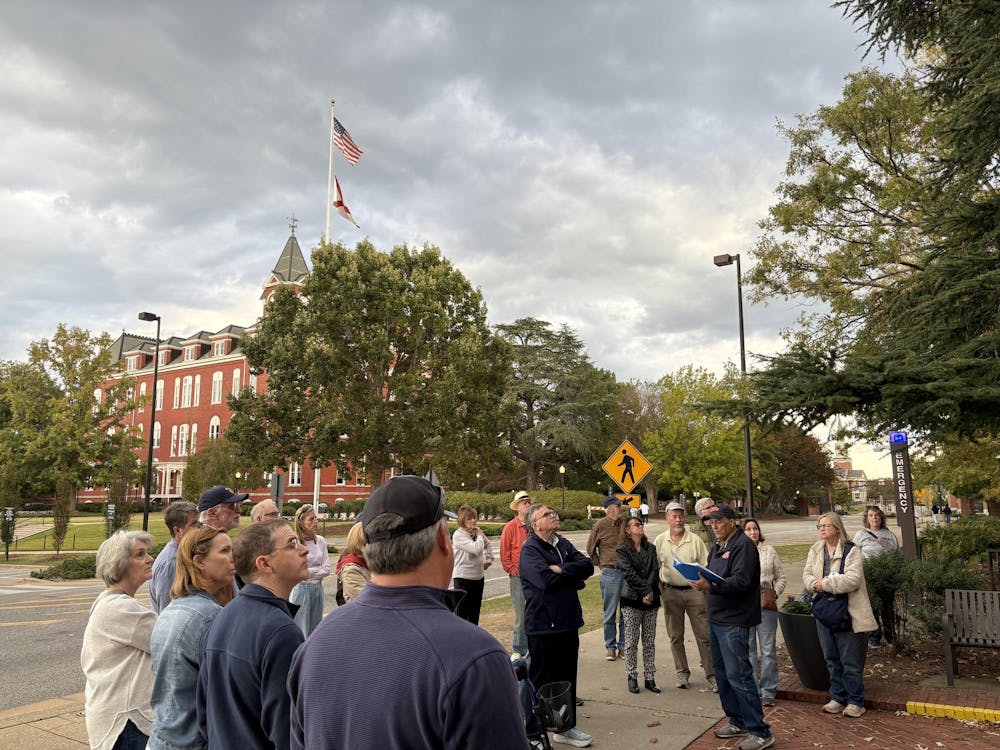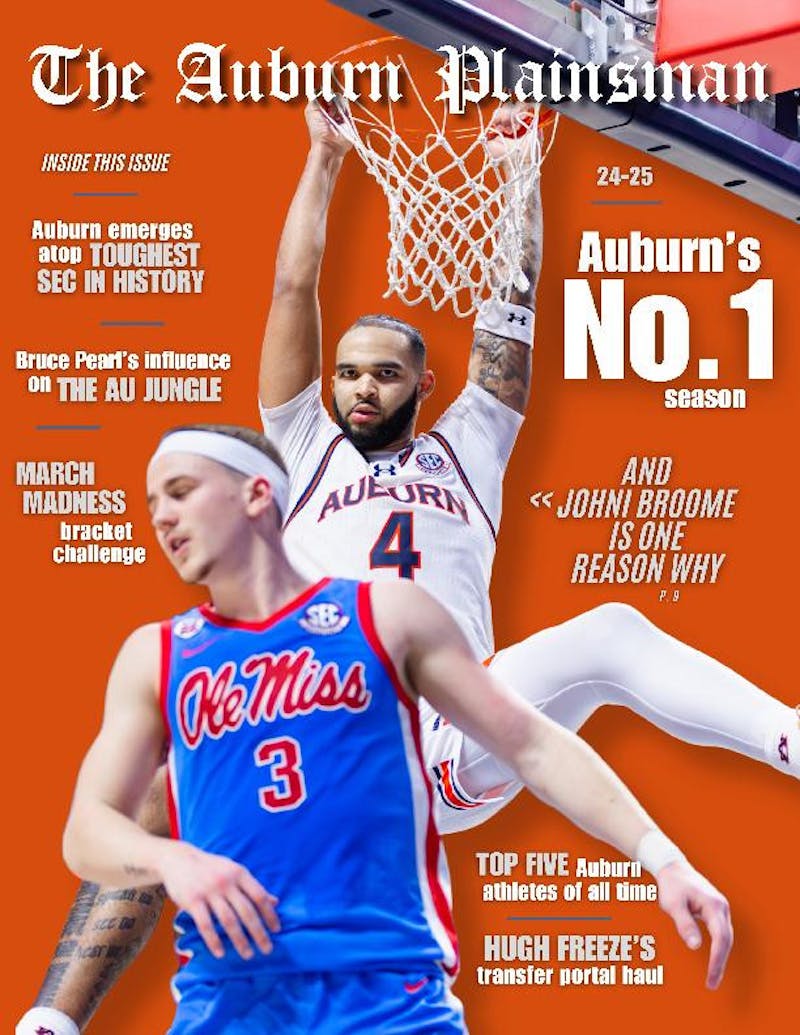On Nov. 2, Sam Hendrix, a local author and historian, led a walking tour around what used to be known as "Faculty Row." Beginning at Auburn Oil Co. Booksellers, Hendrix discussed his in-depth research into the notable figures of Auburn University throughout the 19th and 20th century while leading attendees to locations connected to those faculty members.
Starting at 2 p.m., the event was a free, interesting way to learn more about how Auburn has evolved to become what it is today while enjoying the fall weather, some light exercise and the downtown Auburn scenery.
"Faculty Row," centered around where Auburn University's library now stands, was home to many notable historical figures in Auburn. While most of these homes were destroyed in fires, moved to other locations around town or demolished to make room for Auburn's expanding campus, the history and impact of their residents still remain.
The figures discussed on the tour all contributed so much to the Auburn community that their legacies have been preserved through building and street names. Hendrix studied and researched these stories for his book, "Auburn: A History in Street Names," which ended up being the inspiration and foundation for the tour.
Hendrix didn't always know he wanted to dedicate his life to uncovering forgotten history. Hendix's love for history began when he visited London, England. He then decided to translate that newfound love of history to his love for Auburn.
"From there, I kind of transferred that to the Auburn that I had lived in since 1981, and I found that Auburn has a fascinating history," Hendrix said.
Hendrix further described how he began digging into the history of place names during his graduate school years at Auburn:
"So you're here, and you're going by or in all these building with names on them. Eventually, you find out who that was named for, what they did and why they got a building named for themselves, and the streets are the same way," Hendrix said. "Why do we have those streets? Well, there's a story behind every one of them."
Some of these stories included tales of locally famous faculty, like Gen. Lane, Dr. Petrie, Dr. Mell, Dean Wilmore and Librarian Mary Martin. The tour also covered some of Auburn University's most notable past leaders like President Boyd and President Thach.
The walking tour offered visitors the chance to learn about the achievements that cemented these individuals' legacies in Auburn history, but it also gave attendees the chance to learn about who these Auburn icons were, as people, through the events that happened in their lives.

The Faculty Row Walking Tour stopping by Ralph Brown Draughon Library.
"There's all these fun stories, quirky stories, tragedies, stories of people behaving very badly," Hendrix said.
Alongside these detailed stories, pictures and maps were shown to help contextualize and visualize what Auburn was like at the time.
Some anecdotes from the outing that particularly amused visitors included the homemade bowling alley that Mell built in his backyard, the mule put in Petrie's office after he kicked four freshmen out of his classroom, and Stubbs, who was a professor known for being so loud that other lecturers in the same building as him often had to pause what they were saying until Stubbs finished.
Other stories noticeably shocked guests. One story that stuck out was the tragic tale of the Boyd family who lost a son after he and his brother were playing with a hunting rifle left leaning against a tree. His grave at Pine Hill Cemetery was left unmarked and ultimately has yet to be located.
The majority of stories shared were simply fascinating, like the history of Petrie.
According to the tour guide, Petrie was a famous Auburn professor that taught a wide variety of classes and was one of the many icons who called "Faculty Row" home. Petrie was also the first Alabamian to receive a doctorate degree, and he authored the Auburn Creed, which was first published in a 1944 edition of "The Auburn Plainsman."
While Petrie is well-known for his genius, he can also be cited as the father of Auburn's football team and its first head coach. According to Hendrix, Petrie wanted to establish a team at Auburn after studying in Virginia where he was first exposed to a collegiate football team.
Despite receiving no funding from the university to establish the team, Petrie still was able to create a viable football team, which actually included fellow faculty members as players.
"We had a 200-plus-pound electrical engineering professor named Foster McKissick, and he was still young enough to join in on it, and Petrie got him to play. He was the best lineman we had, so here's your electrical engineering guy playing center and leading the way for the running game," Hendrix said.
Hendrix described how Petrie took the new Auburn team to Atlanta where it won its very first game against the University of Georgia, beginning a rivalry that still exists to this day and that some consider to be the oldest rivalry in the Southeastern Conference.
While the walking tour was packed with captivating history, Auburn has so much rich history and so many significant figures that Hendrix has led several other walking tours in 2025. He has another tour coming up on Nov. 21 at 3 p.m. which will begin next to Foy Hall.
Accompanying, helping and encouraging him through his efforts to share Auburn's hidden history is Hendrix's wife, Mary Ellen Hendrix, who also shares a passion for the preservation of Auburn's history.
"It's important to mark someone's presence," Mary Ellen said. "For those stories to now be shared in the community, it gives the residents here a sense of where we come from because every life that came before us here – what we enjoy in Auburn now – it was built on their work, on their successes, on their triumphs."
Those interested in the colorful past of Auburn can learn more at the next free walking tour led by the passionate Hendrix couple, and they can purchase Sam Hendrix's encyclopedic walkthrough of Auburn's background, "Auburn: A History in Street Names," at various bookstores around Auburn, with proceeds from book sales going directly to the university.

Tour guide, author, and local historian, Sam Hendrix, with his book "Auburn: A History in Street Names."
Sam Hendrix is also working on releasing more books about Auburn's history, including a complete history of Auburn's College of Nursing and a detailed account of the massive explosion of a downtown Auburn restaurant that rocked the entire Auburn community in the late 1970s. History buffs and curious community members have even more to look forward to.
Do you like this story? The Plainsman doesn't accept money from tuition or student fees, and we don't charge a subscription fee. But you can donate to support The Plainsman.





